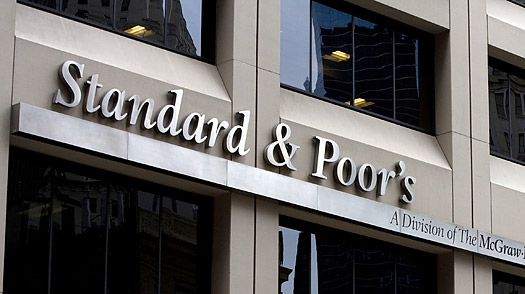LONDON (Standard & Poor’s) July 4, 2011–On June 13, Standard & Poor’s Ratings Services lowered the long-term rating on the Hellenic Republic (Greece) to ‘CCC’ from ‘B’. In part, the downgrade reflected our view of the rising risk that an enhanced official financing package addressing the Greek government’s 2011-2014 financing needs could require private sector debt restructuring in a form that we would view as an effective default of its debt obligations under our ratings criteria. In recent weeks, a number of proposals relating to this topic have surfaced, and the particulars in some cases are evidently still in flux. This credit comment looks at the most prominent of the recent proposals, put forward by the Federation Bancaire Francaise (FBF) on June 24, 2011, in the context of our criteria for evaluating distressed debt exchanges and similar debt restructurings (see Related Research below). In brief, it is our view that each of the two financing options described in the FBF proposal would likely amount to a default under our criteria.
S&P: Debt Rollover Proposal Could Result In A Selective Default For Greece

The FBF proposal currently envisions French-regulated financial institutions agreeing to either of two options regarding their reinvestment of proceeds from Greek government debt maturing between July 2011 and June 2014. Based on recent public statements by European policy makers and bank executives, we believe the options FBF has put forward on the refinancing of Greece’s maturing debt were made at the behest of Greece’s eurozone official creditors. We broadly summarize these options below.
Under the first option, French financial institutions would invest at least 70% of the proceeds of their maturing Greek government bonds in newly-issued 30-year Greek government bonds (New Thirty-Year Bonds). The transferability of the New Thirty-Year Bonds would be restricted for the first 10 years of their tenor (but eligible collateral for ECB repo operations). They would bear interest at 5.5% plus a margin equal to the percentage of real annual growth of the Greek economy, capped at 2.5% and floored at 0%. The Greek government, in turn, would be required to apply a portion of the issuance proceeds to the purchase of zero-coupon 30-year ‘AAA’-rated bonds issued by one or more sovereigns, supranational institutions, or European agencies, with the principal and interest from such ‘AAA’ debt calculated to repay in full the principal amount of the New Thirty-Year Bonds.
Under the second option, French financial institutions would invest at least 90% of the proceeds of their maturing Greek government bonds in newly-issued five-year Greek government bonds (New Five-Year Bonds). The New Five-Year Bonds would also include restrictions on their transferability, and the interest rate coupon would be the same as on the New Thirty-Year Bonds described in option one. We understand there would be no investment of any part of issuance proceeds in ‘AAA’ debt under the second option.
The relevant Standard & Poor’s criteria pertaining to the financing options described in the FBF proposal are found in “General Criteria: Rating Implications of Exchange Offers and Similar Restructurings, Update,” published on RatingsDirect on May 12, 2009. This criteria describes the principles Standard & Poor’s follows when analyzing the credit effects when distressed entities attempt to restructure their obligations. Depending on the circumstances, Standard & Poor’s views certain types of debt exchanges and similar restructurings as equivalent to a payment default. Under our criteria, two conditions must be met for a debt exchange or similar restructuring to qualify as an effective default: (i) the transaction is viewed by us as distressed rather than purely opportunistic, and (ii) we take the view that the “exchange or similar restructuring” will result in investors receiving less value than the promise of the original securities.
Although we do not consider either FBF financing option as strictly being an “exchange,” we are of the view that each falls into the category of what our criteria terms a “similar restructuring.” This is because we believe–based on recent public statements of eurozone policymakers–that the aim of the financing options is to reduce the risk of a near-term debt payment default or debt restructuring with haircuts and give the Greek government more time to undertake fiscal consolidation and policy reforms. We also believe that the proposed options respond to the desire of eurozone creditor governments to slow the growth in their own exposure to Greek government credit risk. We note, too, the public expressions of concern by many policymakers about the potentially damaging consequences of a near-term Greek default of any kind on the capital positions of some European banks and that such a default might trigger greater financial contagion in Europe and globally.
Our criteria further states: “For an exchange offer to be viewed as distressed, we must decide that, apart from the offer, there is a realistic possibility of a conventional default (i.e., the company could file for bankruptcy, become insolvent, or fall into payment default) on the instrument subject to the exchange, over the near to medium term.” In our view, Greece’s near-term reliance on EU/IMF official financing, the government’s difficulty in reducing its sizable fiscal deficit, and the current pricing of Greek government debt in the secondary market all underscore the Hellenic Republic’s weak creditworthiness and, consequently, point to a “realistic possibility” that either financing option would fit the “distressed” category. (We also note the announcement on July 1, 2011, by the Institute of International Finance–a global organization with membership drawn, among others, from large banks, insurance companies, and investment management firms–that some of its members might, under certain conditions, be willing to buy back Greek government bonds at market prices well below par.)
In addition, our criteria outline the characteristics of “distressed transactions” that, individually or collectively, we consider when forming an opinion on whether the resulting newly issued debt has “less value than the promise of the original securities,” a primary condition of a distressed exchange or similar restructuring:
-The combination of any cash amount and principal amount of new securities offered is less than the original par amount;
-The interest rate is lower than the original interest rate;
-The new securities’ maturities extend beyond the original;
-The timing of payments is slowed (e.g., zero-coupon from quarterly paying, or bullet from amortizing); or
-The ranking is altered to more junior.
In our view, the third and fourth characteristics can be found in one or both FBF financing options. In both options, investors would purchase new securities with somewhat higher interest rate coupons than the maturing debt. But unlike other investments investors would have been likely to make with the proceeds of maturing Greek debt, the New Five-Year Bonds and the New Thirty-Year Bonds would have restricted transferability for extended periods–in our view because, given current market conditions, both the New
Five-Year Bonds and the New Thirty-Year Bonds would likely trade at a price significantly below par. In addition, we note that the tenor of the New Thirty-Year Bonds under the first option is far longer than the original maturities of any outstanding Greek government bonds, and we take the view that the intent of such extended maturities is to slow the timing of future principal repayments quite significantly. We also note that speculative-grade rated issuers rarely, if ever, are able to access market financing with such a long tenor. Taking these considerations into account, we believe that both options represent (i) a “similar restructuring” (ii) are “distressed” and (iii) offer “less value than the promise of the original securities” under our criteria. Consequently, if either option were implemented in its current form, absent other mitigating information, we would likely view it as constituting a default under our criteria.
In that event, we would likely lower Greece’s issuer credit rating to ‘SD’, indicating that it had effectively restructured some, but not all, of its bond debt. We also note that an ‘SD’ action on the issuer credit rating would likely occur only once, and that, were either FBF refinancing option implemented, a ‘D’ issue rating would be assigned to the maturing Greek government bonds upon their refinancing in 2011. But, once either option is implemented, we would assign a new issuer credit rating to Greece after a short time reflecting our forward-looking view of Greece’s sovereign credit risk. At the same time, we would likely rate all debt issues, including debt refinanced between 2011 and 2014 under the FBF options, at the same level as Greece’s new issuer credit rating.
In summary, the growing risk that the Hellenic Republic might engage in a distressed debt restructuring was one of the reasons we lowered its rating on June 13 (see, “Long-term Sovereign Rating On Greece Cut To ‘CCC’; Outlook Negative”). While we would likely view the FBF proposal, if it proceeds in its current form, as an effective default, we recognize that it is just one of a number of proposals attempting to address the Greek government’s 2011-2014 financing needs and the sustainability of its future debt burden. We understand that the FBF proposal may change, and it is possible that it could take a form that results in a different rating outcome. Regardless of whether the current FBF proposal is implemented, however, we continue to believe the Hellenic Republic’s uncertain ability to implement the revised EU/IMF program is a key risk weighing on its credit standing.


















